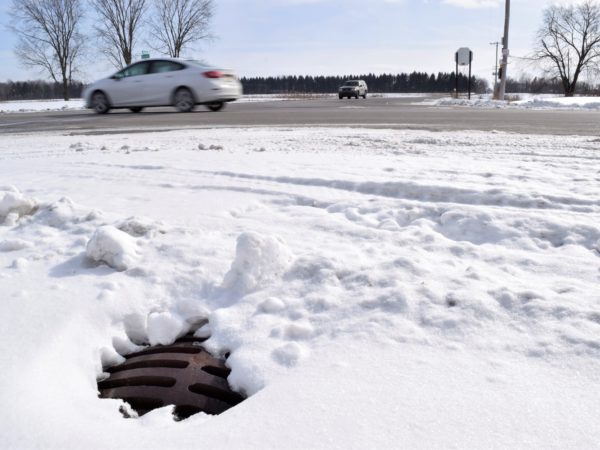
By Henry Redman, Wisconsin Examiner
A former Wisconsin state toxicologist who was involved in creating the state’s nitrate standards for drinking water in the 1980s alleges the science that has informed those standards for decades is deeply flawed and the standards should be stricter.
Dave Belluck, who worked as a toxicologist for multiple states and the federal government, says that “the science is the science” and regulating agencies, including the U.S. Environmental Protection Agency and Wisconsin Departments of Health Services (DHS) and Natural Resources (DNR), should set the standards based on hard data, without regard for economic or political ramifications.
Officials at the state DHS and DNR say they follow the lead of the EPA when setting drinking water standards and that lowering the level at which water is considered safe would have major financial costs without improving the state’s ability to enforce the standards.
Nitrates are a compound of nitrogen and oxygen that occur naturally in the environment and, like other nutrients such as phosphorus, can be helpful as fertilizer. But in high quantities, nitrates can become harmful and cause health defects such as infant methemoglobinemia — also known as blue baby syndrome.
In Wisconsin, nitrates have been a concern for decades largely because of agricultural runoff. Nitrate is the state’s most common groundwater contaminant, according to a 2023 report by the Wisconsin Groundwater Coordinating Council.
In a forthcoming book, Belluck and his wife Sally Benjamin — who has a masters degree in water resource management and a law degree with which she’s focused on environmental law — argue that the current federal drinking water standards for nitrates, which Wisconsin follows for its own standards, are too high because of faulty science that is decades old.
The drinking water standard for nitrates at the EPA and DNR is 10 milligrams of nitrate per liter of drinking water. Wisconsin, which is unique among states for also establishing contaminant limits in groundwater, sets that standard at the same level.
Belluck says that when a standard was first established, scientists tried to find the lowest concentration of nitrates that caused a case of blue baby syndrome. In that research, done in the 1950s, the EPA found that the lowest harmful concentration was 11 mg/L. Setting the standard at 10 then, Belluck says, is going right up to the edge of safety.
“It’s akin to a cliff,” he says. “When you’re standing on the edge of the cliff, you’re safe. You take one step, and it’s just like the Road Runner.”
Belluck and Benjamin dove deeper into the decades of research that the standards are based on and found that in the study in which the harmful concentration of 11 mg/L was found, some infants had gotten sick at concentrations as low as 0.4 mg/L.
Additionally, the couple points out that the EPA states there is zero uncertainty with any of its cited research in the nitrate standard. But that research goes back 70 years and relies heavily upon pieces of data including a health questionnaire used in several states about which there’s no present day knowledge of what questions were asked and how the data was handled after it was collected.
“There’s no record of what the health questionnaire asked,” Belluck says. “We don’t know how they filtered that data. We don’t know who did the sampling from the various states that reported back on the questionnaire. We know nothing about it except what that group wrote about the questionnaire they received.”
Pointing back to science classes in school in which students are taught any scientific paper needs to note the materials and methods used to conduct an experiment, Belluck says the report on which nitrate standards have been based for decades, “couldn’t get through junior high.”
Belluck adds that none of the 1950s research serving as the bedrock of the scientific basis for nitrate standards was peer reviewed.
“It’s almost unlimited uncertainty,” Belluck says of the reliability of that research.
Belluck and Benjamin say the EPA or the Wisconsin DNR and DHS should impose a stricter standard because they believe the science clearly shows nitrates are more harmful than previously thought and nitrites — a closely related compound that can be even more harmful — are even more prevalent than previously thought.
Steve Elmore, DNR’s drinking water and groundwater program director, says nitrates and bacteria are the two contaminants the DNR is most concerned about. He says the agency is “following” work at the federal level to consider if the standard should be lowered and “considering” lowering the standard at the state level, though without taking the formal step of asking DHS to research the topic.
Elmore says that for the drinking water standards, the DNR is “just a vehicle for the federal standards,” but that the state could set lower standards for groundwater. The problem, Elmore says, is that groundwater standards are difficult to enforce. Groundwater is the source of drinking water for the 30% of Wisconsinites who use private wells, but despite the standard, that number functions more as a guideline or recommendation for those people. Between large municipal water systems and private drinking wells are “public” water supplies using groundwater such as wells that serve restaurants, churches and other public places.
For those wells, Elmore says the agency has been working to provide grants to upgrade treatment systems or dig new wells.
Enforcement of the standard at 11 mg/L for large parts of the state is already difficult, Elmore says, so the agency chooses to work more broadly to reduce the amount of nitrates in the environment and try to assist farmers in preventing runoff or finding different methods to fertilize their crops.
“Nitrate, there isn’t a way to trace it, so to speak. We don’t know where it came from,” he says. “We’re certainly not turning a blind eye, we recognize if we have a well with high nitrates in it, it’s likely coming from farm sources right around that well or septic systems or natural materials like breakdown of things like leaves and organic matter. Those are the three big sources. We know it’s coming from them but we can’t tell, are the nitrates in this well coming from farmer A or septic system B? There could be lots of septic systems, lots of farmers that could be contributing to a well. From a science system we can’t say this nitrate is a marker of fertilizer, it’s all nitrate, we can’t fingerprint it.”
That anonymity is “a big challenge” for regulators, Elmore says. Instead of imposing stricter standards on individual polluters, the DNR is pursuing “an overall strategy” to “try to reduce overapplication and reduce leaching nitrates to groundwater.”
Chris Mechenich, who worked for 17 years at UW-Stevens Point’s Central Wisconsin Groundwater Center, says she understands where both Belluck and the state regulators are coming from.
“The regulators aren’t exactly chasing down the polluters and forcing them to do something different,” Mechenich says. “It’s a difficult situation with nitrate because 95% comes from agricultural practices, sometimes even with the best of practices it rains when you don’t expect it to.”
“I think [Belluck], since he wrote the original groundwater standard for nitrate, I think it troubles him,” she continues, adding that the lack of action from regulators makes sense because of the constraints of working in government. Lowering the standard would likely cost municipal water systems millions of dollars to upgrade their treatment methods. The agricultural industry, already the target of enforcement and under pressure from water quality advocates to reduce the amount of nutrients allowed to flow into the state’s water supply, would object. The political blowback from Republicans opposed to the cost and interest groups, with histories of fighting environmental regulations, likely filing lawsuits, would be severe.
“He’s not getting much interest from the regulatory agencies … What are they going to do?” she says. “I understand his point, the standard is the standard and there’s a process for setting the standard and that process is not being followed.”
But Belluck says considering all of that context is “risk management” not science. He says the DNR and DHS should find what the standard should be and propose it, then allow the political process to play out, not avoid the debate altogether.
“Mixing in the non-science elements to influence the science number, that’s risk management, that’s not what we do as scientists,” he says. “Agencies work in a political environment, sometimes they can ignore the non-science parts of the process, other times they can’t.”
Catch more news at Great Lakes Now:
Detroit legislator takes the long view on Michigan’s water affordability struggles
Efforts to thwart regulation of PFAS polluters move down parallel tracks
Featured image: Water fills a glass (Great Lakes Now Episode 1012)




